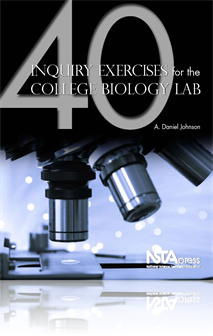All Book Chapters
Book Chapter
Students will use weight potometry to estimate the basal rate of transpiration for bean plants. For the exercise, they will estimate the soil salinity necessary to stop transpiration by mung bean seedlings. Subsequently, students will have the opport...
Book Chapter
Metabolism and Oxygen Consumption
In this unit, students first conduct an experiment to determine if there is a relationship between environmental temperature and rate of metabolism in crayfish (Orconectes). Students also look at whether there is any effect of body size on specific m...
Book Chapter
In this unit, students compare allocation strategies among plant species and within a species under different abiotic conditions. Students will quantify how seedlings of several common crop plants allocate their carbon and nitrogen resources by measu...
Book Chapter
In this unit, students explore how biotic and abiotic factors affect population growth. They explore the effects of competition on growth of different species of molds. Students have actively growing cultures with which to make an inoculation mix of ...
Book Chapter
Measuring Biological Diversity
Biological diversity is a hallmark of life on Earth. In this unit, students estimate biological diversity in two different aquatic ecosystems. They collect water and bottom detritus from two locations and make field notes about the locations. Each wo...
Book Chapter
Designing Scientific Experiments
In this unit, students learn about designing sound, testable hypotheses and experiments. A testable hypotheses is one that is stated in a way that makes predictions that can be tested. The goal of the unit is for students to unravel a simple biologic...
Book Chapter
In a typical Mendelian genetics lab, students cross flies or other organisms of known genotypes, score phenotypes of the offspring, and determine if their results are significantly different from expected phenotype ratios. For this unit, the traditio...
Book Chapter
In this unit, students will isolate DNA suitable for sequencing and other analyses. Students use bioinformatics software to find differences between normal and mutant DNA sequences, then use DNA restriction mapping to confirm the differences. In orde...
Book Chapter
Enzymes are specified proteins that catalyze chemical reactions in biological systems without being permanently changed or used up. This unit was developed to help students gain a more functional, intuitive understanding of how enzymes work, what fac...
Book Chapter
This unit focuses on properties and functions of enzymes. Students will discover for themselves how enzyme concentration, environmental conditions, and potential inhibitors affect enzymes. The unit is more challenging for students as they must apply ...
Book Chapter
The process of photosynthesis is the key to life on Earth. In this unit, students will learn to make an enriched chloroplast preparation from spinach leaves. They will measure relative redox activity by mixing them with DCIP, an indicator dye that c...
Book Chapter
In this unit, students look at the signal transduction pathways that let cells sense and respond to their external and internal environments. The model organism is the free-living unicellular algae, Chlamydomonas reinhardtii. Chlamydomonas is extrem...
Book Chapter
In this unit, students explore hormonal regulation of insect development. Students look at fruit flies—Drosophila melanogaster—in various stages in their life cycles and expose larval flies to a range of concentrations of juvenile hormone. Final...
Book Chapter
In this unit, students learn about the neuromuscular system by dissecting the sciatic nerve and gastrocnemius muscle from the leg of a frog and connecting them to a force transduction apparatus. Then they learn to record myograms from the muscle prep...
Book Chapter
A Brief Introduction to Inquiry
When the term inquiry comes up in conversations about science curriculum reform and improvement, it usually is shorthand for inquiry-based learning and, by extension, inquiry-based instruction. But, what exactly is meant by inquiry-based learning? In...


